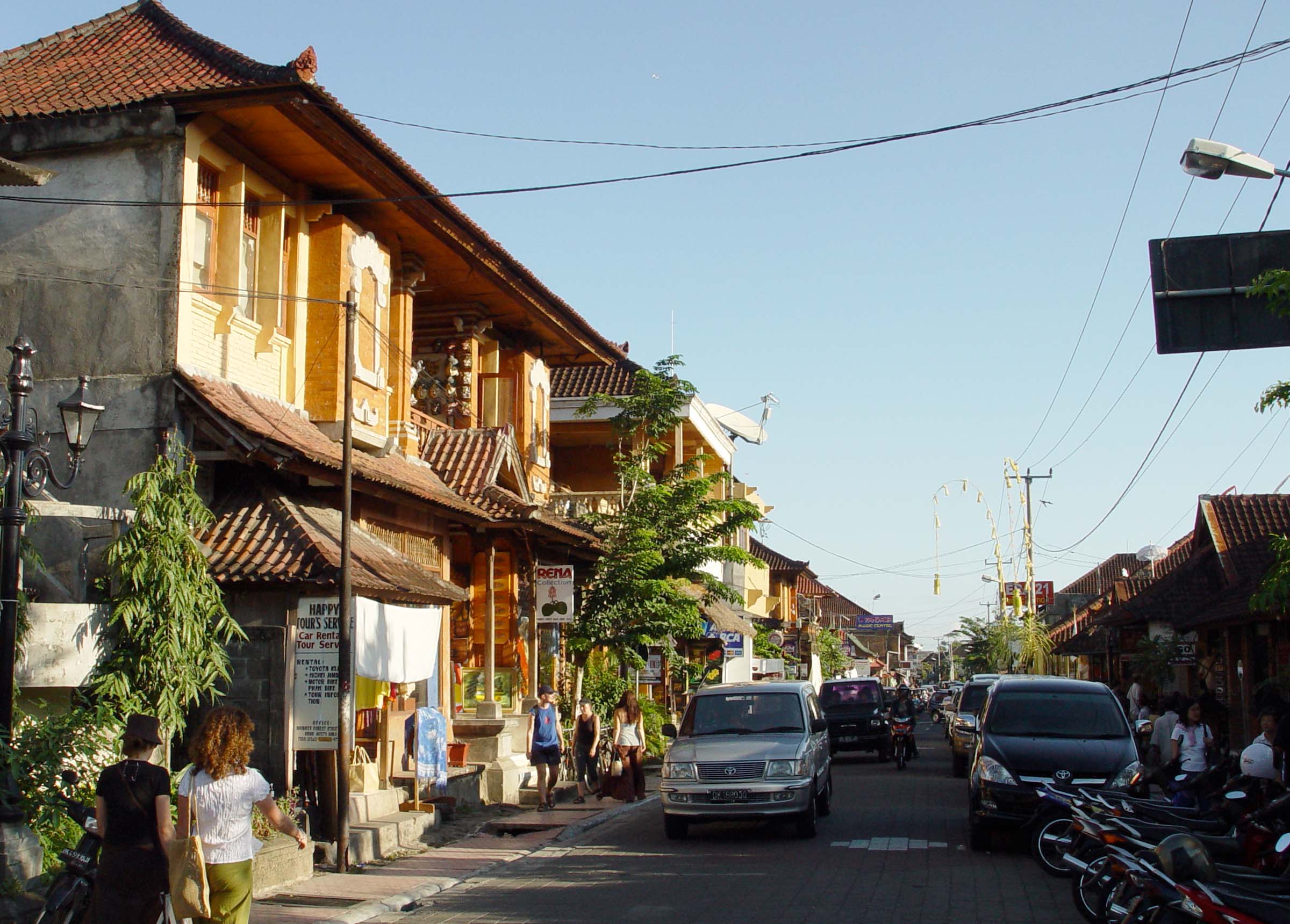- Ubud
Infobox Settlement
official_name = PAGENAME
other_name =
native_name =
nickname =
settlement_type =
motto =
imagesize = 250px
image_caption = Monkey Forest Road, one of Ubud's main thoroughfares
flag_size =
image_
seal_size =
image_shield =
shield_size =
image_blank_emblem =
blank_emblem_type =
blank_emblem_size =
mapsize =
map_caption =
mapsize1 =
map_caption1 =
image_dot_
dot_mapsize =
dot_map_caption =
dot_x = |dot_y =
pushpin_
pushpin_label_position =bottom
pushpin_map_caption =Location in Indonesia
subdivision_type = Country
subdivision_name =Indonesia
subdivision_type1 = Province
subdivision_name1 =Bali
subdivision_type2 =
subdivision_name2 =
subdivision_type3 =
subdivision_name3 =
subdivision_type4 =
subdivision_name4 =
government_footnotes =
government_type =
leader_title =
leader_name =
leader_title1 =
leader_name1 =
leader_title2 =
leader_name2 =
leader_title3 =
leader_name3 =
leader_title4 =
leader_name4 =
established_title =
established_date =
established_title2 =
established_date2 =
established_title3 =
established_date3 =
area_magnitude =
unit_pref =Imperial
area_footnotes =
area_total_km2 =
area_land_km2 =
area_water_km2 =
area_total_sq_mi =
area_land_sq_mi =
area_water_sq_mi =
area_water_percent =
area_urban_km2 =
area_urban_sq_mi =
area_metro_km2 =
area_metro_sq_mi =
area_blank1_title =
area_blank1_km2 =
area_blank1_sq_mi =
population_as_of =2005
population_footnotes =
population_note =
population_total =
population_density_km2 =
population_density_sq_mi =
population_metro =
population_density_metro_km2 =
population_density_metro_sq_mi =
population_urban =
population_density_urban_km2 =
population_density_urban_sq_mi =
population_blank1_title =Ethnicities
population_blank1 =
population_blank2_title =Religions
population_blank2 =
population_density_blank1_km2 =
population_density_blank1_sq_mi =
timezone =
utc_offset =
timezone_DST =
utc_offset_DST =
latd=8|latm=31|lats=12 |latNS=S
longd=115 |longm=15|longs=36 |longEW=E
elevation_footnotes =
elevation_m =
elevation_ft =
postal_code_type =
postal_code =
area_code =
blank_name =
blank_info =
blank1_name =
blank1_info =
website =
footnotesUbud is a town on the
Indonesia n island ofBali . The town is located amongst rice paddies and steep ravines in the island's central foothills in the Gianyar regency. One of Bali's major arts and culture centres, it has developed a large tourism industry.Ubud has a population of about 8,000 people, but it is becoming difficult to distinguish the town itself from the villages that once surrounded it.
History
8th century legend tells of a Javanese priest, Rsi Markendya, meditated at the confluence of two rivers (an auspicious site for Hindus) at the Ubud locality of Campuan. Here he founded the Gunung Lebah Temple on the valley floor, the site of which remains a pilgrim destination.Picard (1995)]
The town was originally important as a source of medicinal herbs and plants; Ubud gets it name from the Balinese word "ubad" (medicine).
In the late nineteenth century, Ubud became the seat of feudal lords who owed their allegiance to the king of
Gianyar , at one time the most powerful of Bali's southern states. The lords were members of the "satriya" family of Sukawati, and were significant supporters of the village's increasingly renowned arts scene.Tourism on the island developed when
Walter Spies came to Ubud, an ethnic German born in Russia who taught painting and music, and dabbled in dance. Spies and foreign painters Willem Hofker and Rudolf Bonnet entertained celibrities includingCharlie Chaplin ,Noel Coward ,Barbara Hutton ,H.G. Wells andVicki Baum . They brought in some of the greatest artists from all over Bali to teach and train the Balinese in arts, helping Ubud become the cultural centre of Bali. A new burst of creative energy came in the 1960's in the form of Dutch painterArie Smit (1916-), developing The Young Artists Movement. There are many museums spread all over Ubud, includingMuseum Rudana .The Bali tourist boom since the late 1960s as seen much development in the town, however, it remains a centre of artistic pursuit.
Town orientation and tourism
The main street is Jalan Raya Ubud, which runs east-west through the center of town. Two long roads, Jalan Monkey Forest and Jalan Hanoman, extend south from Raya Ubud. Puri Saren Agung is a large palace located at the intersection of Monkey Forest and Raya Ubud roads. The home of Tjokorde Gede Agung Sukawati (1910-1978), the last "king" of Ubud, his descendants currently live there and dance performances are held in its courtyard. It was also one of Ubud's first hotels, dating back to the 1930s.
The
Ubud Monkey Forest is a small nature reserve located near the southern intersection of Jalan Monkey Forest and Jalan Hanoman. It houses a temple and over 200 long-tailedmacaque ("Macaca fascicularis") monkeys. About 5km to the west Ubud is theAyung River and the village of Sayan, home to many upmarket hotels like the Four Seasons. Ubud is located at coord|8|31|12|S|115|15|36|E|Tourism to Ubud has a focus on culture and nature. In contrast to main tourist area in southern Bali, Ubud has forests, a river, and cooler temperatures. A number of smaller "boutique" style hotels are located in and around Ubud, which commonly offer spa treatments by the foothills or treks up Ubud's mountains.
Notes
References
*Picard, Kunang Helmi (1995) "Artifacts and Early Foreign Influences". From cite book
last = Oey | first = Eric (Editor) | title = Bali | publisher = Periplus Editions | date = 1995 | location = Singapore | pages = pp. 130-133 | isbn = 962-593-028-0Further reading
* Copeland, Jonathan in consultation with Ni Wayan Murni (2008) "Secrets of Bali, Fresh Light on the Morning of the World". Gateway Books International
External links
* [http://www.walterspies.com/ walterspies.com] - Walter Spies, his work and house in Iseh, Bali
*
Wikimedia Foundation. 2010.

